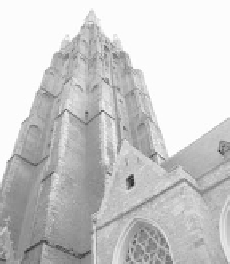Travel Reference
In-Depth Information
that towers 400 feet above, as it has for 600 years. You're heading
for that church.
• Walk left out of the courtyard, doubling back the way you came, toward
the pedestrian bridge. But this time, go right after the archway, circling
clockwise around the outside of the church. Ahead on the right is the
entrance to the...
Church of Our lady
This church stands as a memorial to
the power and wealth of Bruges in
its heyday.
A delicate
Madonna and Child
by Michelangelo
(1504) is near
the apse (to the right as you enter),
somewhat over whelmed by the
ornate Baroque niche it sits in. It's
said to be the only Michelangelo
statue to leave Italy in his lifetime,
bought in Tuscany by a wealthy
Bruges businessman, who's buried beneath it.
As Michelangelo chipped away at the masterpiece of his
youth,
David,
he took breaks by carving this one in 1504. Mary,
slightly smaller than life-size, sits, while
young Jesus stands in front of her. Their
expressions are mirror images—serene,
but a bit melancholy, with downcast eyes,
as though pondering the young child 's
dangerous future. Though they're lost in
thought, their hands instinctively link, ten-
derly. The white Carrara marble is highly
polished, something Michelangelo only did
when he was certain he'd gotten it right.
If you like tombs and church art, pay
€2.50 to wander through the apse (also cov-
ered by €6 Gruuthuse admission and museum combo-ticket). The
highlight is the reclining statues marking the tombs of the last
local rulers of Bruges, Mary of Burgundy, and her father, Charles
the Bold. The dog and lion at their feet are symbols of fidelity and
courage.
In 1482, when 25-year-old Mary of Burgundy tumbled from
a horse and died, she left behind a toddler son and a husband who
was heir to the Holy Roman Empire. Beside her lies her father,
Charles the Bold, who also died prematurely, in war. Their twin
deaths meant Bruges belonged to Austria, and would soon be swal-
lowed up by the empire and ruled from afar by Habsburgs—who
didn't understand or care about its problems. Trade routes shifted,




















